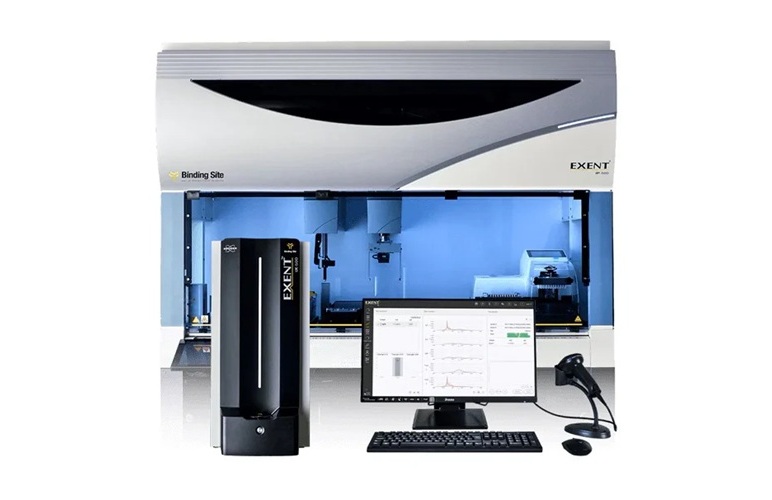Troponin Blood Test Offers Quick Method for Monitoring Patients After Cardiac Surgery
|
By LabMedica International staff writers Posted on 03 May 2022 |

Globally about two million adults a year undergo heart surgery and while the procedure prolongs life and improves quality of life, it comes with the risk of serious complications and death. Validating a method with which to predict heart surgery patients most at risk is a big win. A large international study has now identified a first ever marker that is fast and reliable for the monitoring of patients after cardiac surgery.
The study named VISION Cardiac Surgery by researchers at the Population Health Research Institute (PHRI, Hamilton, ON, Canada) has found that the measurement of troponin – a type of protein found in the heart muscle – in patients undergoing heart surgery offers a better way to measure the risk for heart surgery patients. Taken via a simple blood test, troponin was discovered in an earlier study (VISION) to be an effective predictor of risks facing non-cardiac surgery patients. Troponin is not commonly measured after heart surgery, including coronary artery bypass grafting or open-heart surgery such as valve repairs and replacements. As a result, recommendations by medical experts have widely varied (10 to 70 times the lab normal value) regarding troponin levels that define heart attack and one of the most common complications after heart surgery – myocardial injury.
The new study addressing cardiac surgery patients involved 15,984 adult patients (average age just over 63 years) undergoing cardiac surgery. Patients were from 12 countries, more than a third of which were countries outside of North America and Europe. The study team found that by 30 days after heart surgery, 2.1% of patients had died, and 2.9% had experienced a major vascular complication such as heart attack, stroke or life-threatening blot clot.
In the VISION Cardiac Surgery study, “we found that the levels of troponin associated with an increased risk of death within 30 days were substantially higher - 200 to 500 times the normal value - than troponin levels that surgical teams are currently told defines the risk of a patient having myocardial injury,” said PHRI Scientist PJ Devereaux who led the VISION study and was a lead investigator on the new study.
“This study is a landmark for the health teams taking care of patients after cardiac surgery,” added André Lamy, a study investigator, PHRI Scientist and heart surgeon.
“Our findings will help further studies look at the timing of treatments and procedures to improve patient outcomes after heart surgery,” said investigator Richard Whitlock, also a heart surgeon and PHRI Scientist.
Related Links:
PHRI
Latest Molecular Diagnostics News
- First-Of-Its-Kind Automated System Speeds Myeloma Diagnosis
- Blood Protein Profiles Predict Mortality Risk for Earlier Medical Intervention
- First Of Its Kind Blood Test Detects Gastric Cancer in Asymptomatic Patients
- Portable Molecular Test Detects STIs at POC in 15 Minutes
- Benchtop Analyzer Runs Chemistries, Immunoassays and Hematology in Single Device
- POC Bordetella Test Delivers PCR-Accurate Results in 15 Minutes
- Pinprick Blood Test Could Detect Disease 10 Years Before Symptoms Appear
- Refined C-Reactive Protein Cutoffs Help Assess Sepsis Risk in Preterm Babies
- Blood Test Accurately Detects Brain Amyloid Pathology in Symptomatic Patients
- New Molecular Test Improves Diagnostic Accuracy of Lyme Disease
- New Genetic Test Enables Faster Diagnosis of Rare Diseases
- Urine Test Detects Inherited Neuropathy Missed by Genetic Screening
- Genomic Test Predicts Risk of SCC Metastasis
- Microfluidic Device Predicts Pancreatic Cancer Recurrence After Surgery
- New Molecular Test Simultaneously Detects Three Major Fungal Infections
- Blood Test Guides More Effective Ovarian Cancer Treatment
Channels
Clinical Chemistry
view channel
Chemical Imaging Probe Could Track and Treat Prostate Cancer
Prostate cancer remains a leading cause of illness and death among men, with many patients eventually developing resistance to standard hormone-blocking therapies. These drugs often lose effectiveness... Read more
Mismatch Between Two Common Kidney Function Tests Indicates Serious Health Problems
Creatinine has long been the standard for measuring kidney filtration, while cystatin C — a protein produced by all human cells — has been recommended as a complementary marker because it is influenced... Read moreMolecular Diagnostics
view channel
First-Of-Its-Kind Automated System Speeds Myeloma Diagnosis
More than 176,000 people are diagnosed with multiple myeloma worldwide each year, yet the current diagnostic pathway can be slow and uncertain, often relying on a highly subjective interpretation of test results.... Read more
Blood Protein Profiles Predict Mortality Risk for Earlier Medical Intervention
Elevated levels of specific proteins in the blood can signal increased risk of mortality, according to new evidence showing that five proteins involved in cancer, inflammation, and cell regulation strongly... Read moreHematology
view channel
Platelet Activity Blood Test in Middle Age Could Identify Early Alzheimer’s Risk
Early detection of Alzheimer’s disease remains one of the biggest unmet needs in neurology, particularly because the biological changes underlying the disorder begin decades before memory symptoms appear.... Read more
Microvesicles Measurement Could Detect Vascular Injury in Sickle Cell Disease Patients
Assessing disease severity in sickle cell disease (SCD) remains challenging, especially when trying to predict hemolysis, vascular injury, and risk of complications such as vaso-occlusive crises.... Read more
ADLM’s New Coagulation Testing Guidance to Improve Care for Patients on Blood Thinners
Direct oral anticoagulants (DOACs) are one of the most common types of blood thinners. Patients take them to prevent a host of complications that could arise from blood clotting, including stroke, deep... Read moreImmunology
view channel
Gene Signature Test Predicts Response to Key Breast Cancer Treatment
DK4/6 inhibitors paired with hormone therapy have become a cornerstone treatment for advanced HR+/HER2– breast cancer, slowing tumor growth by blocking key proteins that drive cell division.... Read more
Chip Captures Cancer Cells from Blood to Help Select Right Breast Cancer Treatment
Ductal carcinoma in situ (DCIS) accounts for about a quarter of all breast cancer cases and generally carries a good prognosis. This non-invasive form of the disease may or may not become life-threatening.... Read moreMicrobiology
view channel
Rapid Assay Identifies Bloodstream Infection Pathogens Directly from Patient Samples
Bloodstream infections in sepsis progress quickly and demand rapid, precise diagnosis. Current blood-culture methods often take one to five days to identify the pathogen, leaving clinicians to treat blindly... Read more
Blood-Based Molecular Signatures to Enable Rapid EPTB Diagnosis
Extrapulmonary tuberculosis (EPTB) remains difficult to diagnose and treat because it spreads beyond the lungs and lacks easily accessible biomarkers. Despite TB infecting 10 million people yearly, the... Read more
15-Minute Blood Test Diagnoses Life-Threatening Infections in Children
Distinguishing minor childhood illnesses from potentially life-threatening infections such as sepsis or meningitis remains a major challenge in emergency care. Traditional tests can take hours, leaving... Read more
High-Throughput Enteric Panels Detect Multiple GI Bacterial Infections from Single Stool Swab Sample
Gastrointestinal (GI) infections are among the most common causes of illness worldwide, leading to over 1.7 million deaths annually and placing a heavy burden on healthcare systems. Conventional diagnostic... Read morePathology
view channel
AI Tool Outperforms Doctors in Spotting Blood Cell Abnormalities
Diagnosing blood disorders depends on recognizing subtle abnormalities in cell size, shape, and structure, yet this process is slow, subjective, and requires years of expert training. Even specialists... Read more
AI Tool Rapidly Analyzes Complex Cancer Images for Personalized Treatment
Complex digital biopsy images that typically take an expert pathologist up to 20 minutes to assess can now be analyzed in about one minute using a new artificial intelligence (AI) tool. The technology... Read moreTechnology
view channel
AI Saliva Sensor Enables Early Detection of Head and Neck Cancer
Early detection of head and neck cancer remains difficult because the disease produces few or no symptoms in its earliest stages, and lesions often lie deep within the head or neck, where biopsy or endoscopy... Read more
AI-Powered Biosensor Technology to Enable Breath Test for Lung Cancer Detection
Detecting lung cancer early remains one of the biggest challenges in oncology, largely because current tools are invasive, expensive, or unable to identify the disease in its earliest phases.... Read moreIndustry
view channel
Abbott Acquires Cancer-Screening Company Exact Sciences
Abbott (Abbott Park, IL, USA) has entered into a definitive agreement to acquire Exact Sciences (Madison, WI, USA), enabling it to enter and lead in fast-growing cancer diagnostics segments.... Read more








 (3) (1).png)















